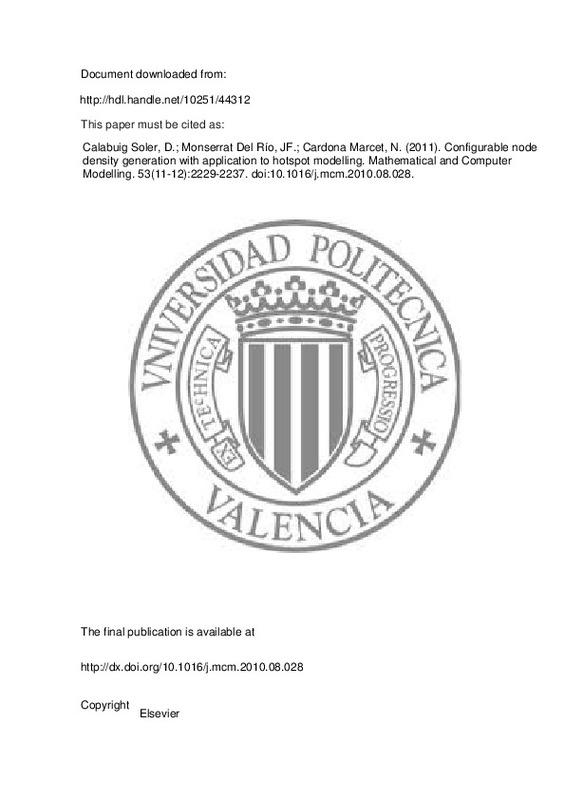JavaScript is disabled for your browser. Some features of this site may not work without it.
Buscar en RiuNet
Listar
Mi cuenta
Estadísticas
Ayuda RiuNet
Admin. UPV
Configurable node density generation with application to hotspot modelling
Mostrar el registro sencillo del ítem
Ficheros en el ítem
| dc.contributor.author | Calabuig Soler, Daniel
|
es_ES |
| dc.contributor.author | Monserrat del Río, José Francisco
|
es_ES |
| dc.contributor.author | Cardona Marcet, Narciso
|
es_ES |
| dc.date.accessioned | 2014-11-17T15:11:45Z | |
| dc.date.available | 2014-11-17T15:11:45Z | |
| dc.date.issued | 2011-06 | |
| dc.identifier.issn | 0895-7177 | |
| dc.identifier.uri | http://hdl.handle.net/10251/44312 | |
| dc.description.abstract | Mobility models are very relevant mainly when studying the performance of wireless systems by means of computer simulations. The main problem arises when deciding the best mobility model for a particular application. In some cases, it is very important to emulate hotspots or, in general, zones with different user (or node) densities. Current models do not allow complete control over hotspots, or in other words, they do not allow any general node density to be defined in the simulation area. Usually, when hotspots are modelled, closed zones are created with different numbers of users in each area, thus ensuring a fixed node density in each area. However, this approach results in an unfair comparison among users since they cannot move across zones. This paper proposes a new mechanism to solve these drawbacks. Using this mechanism, any general node density can be emulated allowing nodes to move around the entire simulation area. Any mobility model can be applied together with this density control mechanism, provided that the mobility model ensures a uniform node distribution. © 2010 Elsevier Ltd. | es_ES |
| dc.description.sponsorship | This work has been funded by the Spanish Ministry of Science and Innovation under project TEC2008-06817-C02-01/TEC. | en_EN |
| dc.language | Inglés | es_ES |
| dc.publisher | Elsevier | es_ES |
| dc.relation.ispartof | Mathematical and Computer Modelling | es_ES |
| dc.rights | Reserva de todos los derechos | es_ES |
| dc.subject | Hotspots | es_ES |
| dc.subject | Mobility model | es_ES |
| dc.subject | Node density | es_ES |
| dc.subject | Complete control | es_ES |
| dc.subject | Configurable | es_ES |
| dc.subject | Current models | es_ES |
| dc.subject | Density control | es_ES |
| dc.subject | Fixed nodes | es_ES |
| dc.subject | Hot spot | es_ES |
| dc.subject | New mechanisms | es_ES |
| dc.subject | Node distribution | es_ES |
| dc.subject | Wireless systems | es_ES |
| dc.subject | Models | es_ES |
| dc.subject | Computer simulation | es_ES |
| dc.subject.classification | TEORIA DE LA SEÑAL Y COMUNICACIONES | es_ES |
| dc.title | Configurable node density generation with application to hotspot modelling | es_ES |
| dc.type | Artículo | es_ES |
| dc.identifier.doi | 10.1016/j.mcm.2010.08.028 | |
| dc.relation.projectID | info:eu-repo/grantAgreement/MICINN//TEC2008-06817-C02-01/ES/ADVANCED LONG TERM EVOLUTION UNICAST AND MULTICAST JOINT RESOURCE ALLOCATION/ | es_ES |
| dc.rights.accessRights | Abierto | es_ES |
| dc.contributor.affiliation | Universitat Politècnica de València. Instituto Universitario de Telecomunicación y Aplicaciones Multimedia - Institut Universitari de Telecomunicacions i Aplicacions Multimèdia | es_ES |
| dc.contributor.affiliation | Universitat Politècnica de València. Departamento de Comunicaciones - Departament de Comunicacions | es_ES |
| dc.description.bibliographicCitation | Calabuig Soler, D.; Monserrat Del Río, JF.; Cardona Marcet, N. (2011). Configurable node density generation with application to hotspot modelling. Mathematical and Computer Modelling. 53(11-12):2229-2237. https://doi.org/10.1016/j.mcm.2010.08.028 | es_ES |
| dc.description.accrualMethod | S | es_ES |
| dc.relation.publisherversion | http://dx.doi.org/10.1016/j.mcm.2010.08.028 | es_ES |
| dc.description.upvformatpinicio | 2229 | es_ES |
| dc.description.upvformatpfin | 2237 | es_ES |
| dc.type.version | info:eu-repo/semantics/publishedVersion | es_ES |
| dc.description.volume | 53 | es_ES |
| dc.description.issue | 11-12 | es_ES |
| dc.relation.senia | 41309 | |
| dc.contributor.funder | Ministerio de Ciencia e Innovación | es_ES |







![[Cerrado]](/themes/UPV/images/candado.png)

